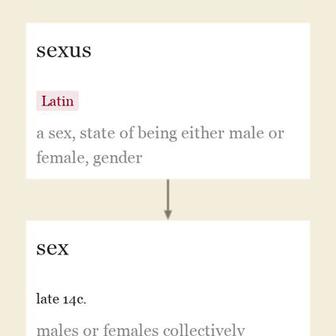intersex (n.)
"具有两性特征的人",1917年,源自德语 intersexe(1915); 参见 inter- "之间" + sex(n.)。由德国出生的美国遗传学家理查德·本尼迪克特·戈德施密特(Richard Benedict Goldschmidt,1878-1958)创造。 Intersexual 自1866年起用作"存在于两性之间,涉及两性"; 自1916年起用作"具有男性和女性特征"。相关词汇: intersexuality。
intersex 的相关词汇
这是一个在英语中自由使用的词缀,表示“在...之间,期间”,源自拉丁语 inter(介词,副词)“在...之间,中间”(也广泛用作前缀),源自原始印欧语言 *enter “在...之间,中间”(源头还包括梵语 antar,古波斯语 antar “在...之间”,希腊语 entera(复数)“肠道”,古爱尔兰语 eter,古威尔士语 ithr “在...之间”,哥特语 undar,古英语 under “在...之下”),是词根 *en “在...之内”的比较级。
这个词缀在15世纪开始在英语中使用,并与日耳曼语和拉丁语词汇一起使用。在法语中拼写为 entre-; 大多数以这种形式借入英语的词汇在16世纪重新拼写为拉丁语形式,除了 entertain, enterprise。在拉丁语中,拼写在 -l- 前转变为 intel-,因此有 intelligence 等词汇。

14世纪末,"男性或女性被视为一个整体",源自拉丁语 sexus "性别,既可以是男性也可以是女性,性别",一个起源不明的词。"通常与 seco 一起被视为种族的分割或'一半'" [塔克尔],这将把它与 secare "分割或切割"联系起来(参见 section(名词))。
Secus seems the more original formation, but it is strange that the older texts only know sexus. The modern meaning of sectiō 'division' suggests that sec/xus might derive from secāre 'to sever', but the morphology remains unclear: does sexus go back to an s-present *sek-s- 'to cut up', or was it derived from a form *sek-s- of the putative s-stem underlying secus? [Michiel de Vaan, "Etymological Dictionary of Latin and the other Italic Languages," Leiden, 2008]
Secus 似乎是更原始的形式,但奇怪的是,早期的文本只知道 sexus。sectiō 的现代意义为“分割”表明 sec/xus 可能源自 secāre 的“切割”,但形态学仍不清楚: sexus 是否追溯到一个 s-现在分词 *sek-s- 的“切割”,还是源自 secus 下的假定 s-词干的形式 *sek-s-?[Michiel de Vaan,《拉丁语和其他意大利语的词源词典》,莱顿,2008]
1520年代记录了与动物有关的“具有男性或女性特征的品质或特性”; 到19世纪,这尤其指“男性和女性的解剖学区别,通过其生殖器官的生理特征和每个人在生殖中所扮演的角色。”到16世纪60年代,这一概念扩展到植物中与动物性别相对应的特征或结构。
It is curious that the Anglo-Saxon language seems to have had no abstract term for sex, which was expressed only severally as manhood or womanhood. [Thomas Wright, note to "Anglo-Saxon and Old English Vocabularies," 1884]
有趣的是,盎格鲁-撒克逊语似乎没有抽象的性别术语,只能分别表示为男子气概或女子气概。[托马斯·赖特,《盎格鲁-撒克逊语和古英语词汇》,1884年注]
特别是 the sex "女性性别,女性"(1580年代)。1906年出现了"性交"(have sex)的意义; 1933年提出了"生殖器官"的意义("形成的烟雾"),可能更早。1871年在人类学中出现了 Sex symbol ,似乎是首次将该术语应用于玛丽莲·梦露(1959年)。1954年出现了 Sex-kitten (布丽吉特·巴尔多)。1901年出现了 Sex object ,最初用于心理学; 1904年出现了 sex appeal 。
For the raw sex appeal of the burlesque "shows" there is no defense, either. These "shows" should be under official supervision, at the least, and boys beneath the age of eighteen forbidden, perhaps, to attend their performance, just as we forbid the sale of liquors to minors. [Walter Prichard Eaton, "At the New Theatre and Others: The American Stage, Its Problems and Performances," Boston, 1910]
对于滑稽戏的原始性感,没有任何辩护的余地。至少,这些"表演"应该受到官方监督,禁止18岁以下的男孩参加,就像我们禁止向未成年人出售酒精一样。[沃尔特·普里查德·伊顿,《在新剧院和其他地方:美国舞台,其问题和表演》,波士顿,1910年]
Sex-life 于1887年出现。1916年出现了 Sex-drive (1911年出现了 sex-impulse)。1894年出现了 Sex-education ; 1969年出现了 sex therapist ,在早期的使用中常常指的是马斯特斯和约翰逊。1907年出现了 Sex-crime ; 1895年出现了 sex-maniac ; 1931年出现了 sex-fiend (在纽约每日新闻的标题中)。